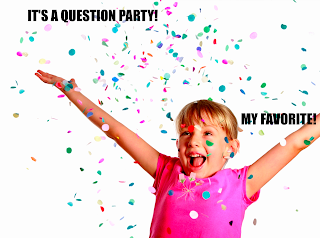
Before I was enrolled in EDM 310, I had been drilled by teachers about my understanding of a subject. By drilled I mean I was given an excessive amount of information, asked a yes or no question of my understanding, and then given a test. I began to believe that this was the only way a teacher should teach. As a future educator myself, I was taking notes on the ways of teaching to develop ideas on how I would teach my future students. Upon arriving in EDM 310, I was given a whole new set of learning rules. Rules that require me to discover for myself, not only what the answer is, but how to best achieve the answer. This helped me realize that teachers are only beneficial to their students when they give them the tools to learn rather than drill them with information and expect them to fully understand a subject. By asking questions, that do not require a yes or no answer, teachers can be better aware of their students' understanding. Question are key to the evaluations of students progress and understanding. In Ben Johnson's article in Edutopia, entitled The Right Way to Ask Questions in the Classroom, I learned that you can not assume that students know everything. I also learned that when asking questions in a classroom you should ask yourself what you want your students to learn from the questions. Simply asking a student if they understand a subject is not enough. Ben Johnson explains that students fill out their teachers to decide what answers the teacher wants to hear. Students may give a yes or no answer, or maybe no answer at all, and still have little to no understanding of a subject. By asking questions the teacher can evaluate for themselves how well a student understands a subject.

On Faculty Focus I read an article entitled Three Ways to Ask Better Questions in the Classroom written by Maryellen Weimer. She explains that there are three things you must do in order to ask better questions. The first thing is to prepare the questions. By preparing questions before hand, the teacher is more organized and minimizes the risk of asking confusing, hard to answer questions. She then says you must play with the questions. She says that "questions are most powerful, when they best engage students, and when they are at their thought-provoking best". She says that questions are most engaging before the answer is given and by playing with the questions, you can create a longer window for thought. Lastly she suggests that as a teacher you should preserve good questions. She says that good questions can be reused and even altered to make better questions. She even claims that good questions, asked by students, can be saved to ask again in the future. She tells teachers that "we should be working on our questioning techniques, not just because our questions are more effective when skillfully used. We need to ask good questions so that students see the importance of questions."
The advice given on questioning students in a classroom given by these two authors, will be very good to keep in mind for my future classrooms. I am learning in the EDM 310 class, that teaching is a lot more than filling a student with information, its about helping them learn how to learn.
Chasity,
ReplyDeleteExcellent post! Very thoughtful. I must reiterate however that you cannot have "unknown" as the source for your images. You found them somewhere and that is the place you must credit in the ALT modifier.
Well written! I thought it was a great idea how you brought in a personal experience into this post. I came across a few spelling errors though but that was all. On the 11th line from the top, you have the word "then" instead of them. The fourth line in the second paragraph, you have the word "prepare" instead of preparing. The fifth line in the same paragraph, you left out the h in the word "te". Lastly you have two a's in the 11th line in the second paragraph.
ReplyDeleteBesides these little spelling errors, it was a well written post!
I really liked the pictures you used. I noticed in your first sentence you put "I had be drilled",I think you meant been instead of be.Also, on the seventh line I would put a comma after upon arriving in EDM 310.
ReplyDelete"I had be drilled by teachers ..." been, not be (others have pointed this out already)
ReplyDeleteSee Bailey's comment on ALT. Did you get the picture from Google. Most of the time Google provides a source. Hunt until you find the source.
Thoughtful. Addresses the question asked. Cites sources.